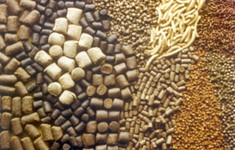 Despite the controversy concerning the possible sale of genetically modified (GM) salmon in the United States — NGOs are now lobbying supermarkets not to carry it — consumers there are already eating farmed fish fed genetically modified ingredients.
Despite the controversy concerning the possible sale of genetically modified (GM) salmon in the United States — NGOs are now lobbying supermarkets not to carry it — consumers there are already eating farmed fish fed genetically modified ingredients.Species such as tilapia and pangasius imported from Southeast Asia, and quite possibly other species from other parts of the world as well, have in all likelihood been fed manufactured diets containing GM soya.
According to industry sources, the use of GM soya in fish feed is widespread and is generally, if quietly, accepted. One fisheries consultant says it is very difficult to obtain non-GM soya anyway. “There is no natural (non-genetically modified) soya to be found anywhere.”
However, Skretting, which claims to be the world leader in the production and supply of feed for farmed fish and shrimp, says it is able to source the non-GM soya it needs from Brazil. Although it appears that this could only be required for European customers.
According to Marit Husa, communications manager, Skretting companies in Europe do not use GM ingredients in feed whenever it is requested by customers.
Norwegian aquaculture feeds manufacturer, EWOS said more or less the same.
“EWOS does not use any genetically modified raw materials in Europe. Neither EWOS Norway nor EWOS U.K. uses GMO soy products,” said Lise Andreasen.
The situation is different in other countries, however.
“We can use GM soya in feed in those countries where it is permitted and our customers, the retailers and consumers accept it, as it helps to keep down the cost of feed,” said Husa.
The perceived rejection of GM ingredients fed to farmed fish in Europe is very much driven by retailers, Husa said. “Even though they accept other animal proteins such as poultry, pig and beef fed with GM soya!”
Not all retailers are against GM ingredients being fed to the farmed fish they sell. The fisheries manager of one major British supermarket said fish fed GM feed is acceptable “as long as there is no carryover into the fish.”
The certification schemes for farming fish authorized by the Aquaculture Stewardship Council (ASC), GlobalGAP, and similar organizations, which might be expected to oppose the use of GMOs as ingredients in fish feed, skate over the issue.
The ASC “has a neutral position on the use or non-use of GM in feed for aquaculture,” said Bas Geerts, standards director, who admits that soy or soya is in many fish feeds is in most cases GM.
By far the biggest supplier of GM soya is Monsanto — a US company — which has subsidiaries all over the world including Vietnam, the leading producer of pangasius. So, ironically, given their perceived stance over GM salmon, it is more than likely that farmed fish eaten by Americans has been fed GM soya supplied by an American company.
In Europe there is a growing backlash against GM seeds produced by Monsanto. Emails are circulating urging people to help “keep Monsanto’s hands off our food.” It is small wonder then that the likes of Skretting and EWOS do not include GM soya in the aquaculture feeds they sell in Europe while they do so in other parts of the world.
Despite the concerns of NGOs such as Greenpeace and World Wildlife Fund that risks of GM food have not been adequately identified and managed, there is broad scientific consensus that food on the market derived from GM crops poses no greater risk than conventional food.
However, once the powerful environmental groups get their teeth into something, they have the financial muscle and PR expertise to get their message across regardless of scientific opinion.
There is already a storm brewing over GM salmon, will GM ingredients in fish feed be next in the firing line?





